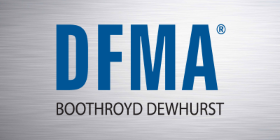DFMA Case Study: Ciba Corning Blood-Gas Analyzer
Overview
Ciba Corning set aggressive targets to modernize its blood-gas analyzer family around a common base platform that could be upgraded in the field. The goals: lower cost, higher quality, durable construction, faster assembly, and easier use.
DFMA Approach
The engineering team paired design and manufacturing engineers from the start and ran all assemblies through DFMA® analysis. That work produced assembly cost estimates and—more importantly—structured conversations about material choices, consolidation opportunities, and part fit/locating features.
Key Design Moves
- Caseworks simplified: Two outer shells hinge together like a suitcase, improving fit and speeding assembly.
- Hydraulics consolidation: The reagent manifold was redesigned as a single acrylic block, removing numerous tubes and fittings.
- Self-locating parts: Pins and dedicated features align components without re-orienting, reducing handling time and error risk.
- Fastening strategy: Balanced use of molded snap-fits and screw bosses/Tinnerman-style solutions to cut hardware and minutes.
Results
- ~48% reduction in total parts count.
- ~60% fewer fluidic connections.
- ~22% lower overall cost.
Prototyping & Validation
Solid modeling and rapid prototyping (including stereolithography, cast urethane, and structural foam) supported the higher functional density created by DFMA-driven part consolidation, enabling quick iteration and fit checks.
Team Perspective
Design and manufacturing worked side-by-side throughout, using DFMA to quantify assembly effort and guide decisions. The focus on self-alignment and single-orientation assembly eliminated wasted motion and made the final build faster and more robust.
What This Means for You
- Use DFMA early to expose simplification opportunities and quantify the impact.
- Co-locate design and manufacturing decisions to close the loop on part fit, features, and fastening.
- Leverage rapid prototyping to validate higher functional density after part consolidation.




